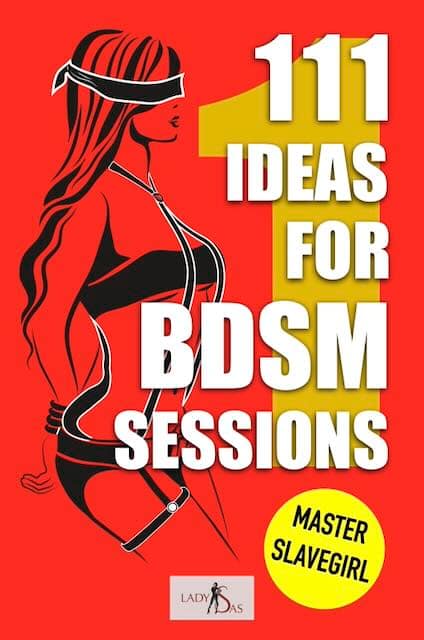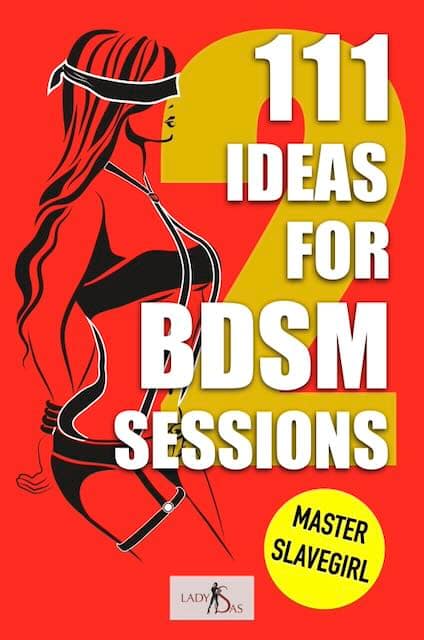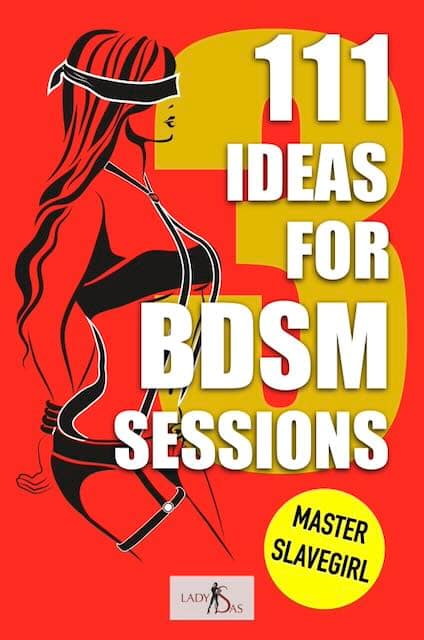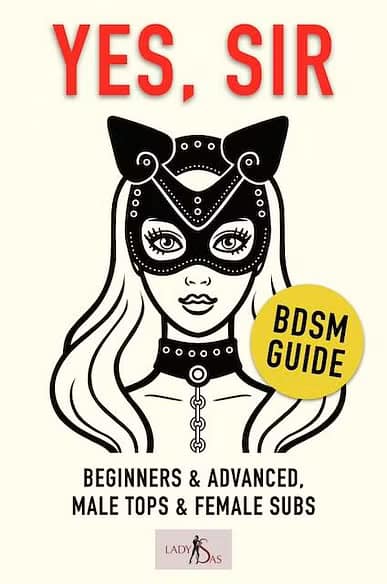BDSM stands for Bondage & Discipline, Dominance & Submission, and Sadism & Masochism. It describes practices and relationship dynamics that involve consensual power exchange.
BDSM Guide by Lady Sas, private BDSM author from Frankfurt am Main · Updated: September 25, 2025
BDSM is a dazzling, expansive playground for consenting adults—and it’s more popular than ever. Author Lady Sas explains what BDSM is, how scenes actually work, and which rules, rituals and safety basics matter. You’ll also get tips, ideas and background knowledge. Enjoy!
BDSM helps adult couples keep their sex life exciting over the long term. Love aside—most couples eventually face routine in the bedroom. BDSM is an excellent way to bring fresh energy because it has many facets and sparks the imagination. I’ve been exploring kink since 2011 and still find: wonderful—there’s always more to discover!
At the center is a power exchange. One person leads (Top), the other follows (Sub). One commands, the other consents to submit.
Important note: There’s no official rulebook for BDSM. You should live your kink the way it brings you joy—by your own rules. Anything that’s consensual and as-safe-as-possible is allowed. Still, especially for beginners, it helps to see how others play. That’s what this BDSM guide is for.
Which roles exist in BDSM?
Essentially, there’s an active and a receptive role. The leading partner is called Top, Dom/Domme, Sir/Lady, Master/Mistress. The receptive role is called Sub, slave, or Bottom.
These variants already show two basic expressions: either the man is dominant or the woman is. When the woman holds power, it’s called Femdom (fem = female, dom = dominant). You’ll find extensive overviews of that domain across our site.
Roles are often stable, but some people enjoy both sides—sometimes Top, sometimes Sub. They’re called switches (often simply called a switch).
Beyond committed relationships, there are play relationships: partners meet to play but aren’t a romantic couple and may be partnered elsewhere. A known dynamic is the FLR—female-led relationship—in which the woman leads and the man follows.
Common misconceptions about roles
A frequent myth is that Subs are weak and “need” leadership. In my experience it’s often the opposite: many Subs are strong, self-assured people willing to explore this adventure. Submissives are often strong inside.
Another myth: only high-powered people submit to compensate for stress. That’s a cliché. Tops and Subs exist across all ages and social backgrounds.

Which areas exist within BDSM?
BDSM spans several broad areas.
- Classic dominance (also “black area”) is role-play where the Top exercises power over the Sub. A Master dominates a slave, or a Mistress dominates her Sub.
- In contrast, the “white area” focuses on medical role-play: the dominant doctor examines the submissive patient—gender roles can be reversed as well. The setting aims to resemble a medical environment.
- Pet play is role-play where the Sub takes the role of an animal—e.g., dog, pig, pony. Some Mistresses even have their human pony pull a cart, driven to peak performance with a long lunge whip.
- Service centers on serving: a Sub may act as a butler for a strict Mistress. For female Subs, the housemaid role is popular under a dominant gentleman. (Think maid/butler, boss/secretary.)
- Military, drill, prison & imprisonment plays with uniforms, ranks, order, and confinement. Some pro-dommes run “prison” scenarios where inmates are disciplined and punished.
- Sissification (feminization) is another large area, often featuring pink, alluring outfits and training to move and act “like a lady” while unlearning stereotypically “male” behaviors. A well-known icon is the American performer Natalie Mars, whom we’ve profiled.
- Findom: the Sub becomes a “paypig,” deriving pleasure from sending money to the adored Mistress to fund her lifestyle. In exchange he may receive mockery and disdain. “Cash & go” refers to very brief, in-person handovers. We also feature interviews with experienced Findoms.
What are the benefits of BDSM?
Why do people get into BDSM? Outsiders often struggle to understand why, for example, a man would willingly submit to his partner (Femdom), embrace discipline and even punishment.
For many submissive men, it simply feels wonderful to enter that role. Put simply, it aligns with their kink. Longer version: many men are under pressure today. Slipping into the Sub role can feel like a vacation. They can switch off, stop leading, hand over responsibility, and enjoy not having to “perform.” That’s a powerful draw.
The Mistress or Master, in turn, enjoys power—deciding, being admired and obeyed.
Motivations are nuanced and personal. In summary:
- Tops enjoy power and freedom.
- Subs enjoy being receptive and allowed to be “weak” (switching off; that vacation feeling).
- Some Subs enjoy activities more because they can say, “I had to do it—I was ‘made’ to,” even though BDSM is consensual.
- The thrill of the forbidden adds to the appeal.
- There’s a bodily component: impact can release chemicals that cause euphoria.
- Both partners can dive into role-play and be who they want—playful, imaginative, and free.
What happens in a BDSM session?
What happens depends on the area and role-play. Generally, the Top is active and leads. The Sub is receptive—speaks only within agreed rules and follows commands (or uses the safeword). BDSM scenes are called “sessions.”
Common locations: rental play spaces or pro-domme studios, private playrooms in kink clubs, play parties, or at home. Many cities offer dedicated BDSM apartments and studios you can rent as a couple.
Classic discipline is structured by rituals: a Dom might begin by placing a collar on his Sub; a Femdom might have the Sub kiss her boots (or hand) in greeting. Goodbyes mirror the start: collar off; a respectful kiss to the boots or hand.
Sessions incorporate BDSM practices. Not every Top is a sadist and not every Sub a masochist. In recent years, classic pain play has become less dominant; power exchange and fetishes are more common.
What is a fetish in BDSM?
A fetish is a highly focused erotic trigger tied to an object, material, body part, or action—often a (co-)primary source of arousal. Typical examples: latex, leather, nylons/stockings, high heels, boots, gloves, corsets, ropes. Among male Subs, nylons and high heels are very common; kissing a Mistress’s elegant heels is a favorite for many.

Which practices exist in BDSM?
Practices are incredibly varied. Here are key types. You’ll find fuller glossaries throughout our site’s lexicon.
- Bondage restrains the Sub so they’re helpless: ropes or chains, collars, wrist and ankle cuffs, hoists, St. Andrew’s cross, etc.
An extreme form is plastic-wrap mummification, fully encasing the Sub in film—risky and only for experienced players. Watch for fainting risk and ensure breathing is never compromised.
For deeper insights, look for interviews with makers and riggers in the community. - Discipline/Impact Play focuses on pain play using tools (paddles, crops, floggers, canes, bullwhips, single-tails). It can shape behavior—and may lead the Sub into subspace, a trance-like, floating state. Physiologically, stress hormones rise first (adrenaline, cortisol); the brain releases endorphins and dopamine. We also provide in-depth Impact Play guides and interviews.
- Pegging: anal penetration of the Sub by a Femdom using a strap-on dildo.
- Weights & clamps: applied to the Sub’s body to create controlled pain stimuli.
- Mind games: psychology matters more than pain for many. Tops play with expectations—e.g., approaching with “stinging nettles” that are actually harmless dead-nettles.
- Breath control/restriction: the Top controls airflow via mask/tubing. This is dangerous and demands strict safety rules and responsibility.
- Bastonado: caning the soles of the feet—very painful (many nerve endings) and often chosen to avoid visible marks.
- Humiliation play: consensual shame dynamics (e.g., slapping, crawling, shoe-kissing, public presentation in clubs). Note: no non-consensual public displays that involve bystanders.
- Figging: a peeled piece of ginger inserted anally for an intense burning sensation.
- Chastity: common in Femdom/male-Sub dynamics. A keyholder keeps the Sub in a chastity device and uses tease & denial to heighten desire—sometimes combined with consensual cuckolding dynamics.
Which BDSM furniture exists?
BDSM furniture supports positioning, safety, and control: the St. Andrew’s cross (X-frame for standing restraint), spanking bench/horse (padded for kneeling or prone), bondage bed or restraint frame with D-rings, bondage chair, and pillory (stocks).
Also common: cages (standing or crawling), gynecological chairs for medical play, bondage tables, suspension frames, and queening/face-sitting chairs.

10 Tips for BDSM Beginners from Lady Sas
Tip 1: Be open to information and inspiration.
You’re reading an information page about BDSM—great start. Study the topic in theory before you dive into practice. The more you know, the better you’ll navigate and avoid mistakes. Stay open. I personally made the mistake at the beginning of blocking out entire BDSM areas because I had a pre-made opinion they weren’t for me. Wrong! Today I enjoy many things I never imagined, like sissification of subs.
Tip 2: Only do what feels good.
The most important word in BDSM is: no. When in doubt, say “no, thanks,” and stay on the safe side. Don’t let yourself be pressured. Listen to your gut. If your gut says no, it’s usually right. Don’t do things just to please someone. Just because a practice exists doesn’t mean you have to try it.
Tip 3: Don’t trust too quickly.
Trust in BDSM has to be earned. Don’t be naive and think: It’ll be fine. Trust a little at first. If all goes well, trust a tiny bit more next time. Take it slowly, step by step.
Tip 4: If someone is in a rush, be suspicious.
Many “Doms” call themselves that just to get quick sex. Experienced BDSM players exude calm and don’t push.
Tip 5: If someone insists on making you submit, be suspicious.
True dominance isn’t loud. It doesn’t shout “On your knees!” Instead, it creates the feeling in the sub of wanting to get on their knees of their own accord.
Tip 6: A good Dom tests painful things on themselves.
That way they can judge what they’re actually causing.
Tip 7: BDSM videos don’t show reality.
Films are often staged perfection. Don’t let that impress you or pressure you to perform the same. Relax. Don’t use films as your benchmark. Maybe the performers tried a scene 20 times, and the film only shows the one take where it worked instantly.
Tip 8: You’ll only be happy when your partner is happy.
The goal is to make the other person happy. Only then will you be happy yourself. Think less about you and more about your partner. That’s the key to your own happiness.
Tip 9: Question all tips from so-called experts.
Not every expert is truly one. Listen to everything, but think and decide for yourself. Walk your own path. There’s no law that regulates BDSM. Everyone may design their own BDSM.
Tip 10: Have fun.
BDSM is a playground for adults. A playground is there to have fun and to experiment. Enjoy!
You don’t have to reinvent the wheel. In the books by my friends Johanna Koltai, Lady Victoria, and me, you’ll find reliable information, helpful instructions, and tried-and-true tips from BDSM practice. Below are a few examples. Here you’ll find the complete catalog of all books and audiobooks.
Note: Authors’ own titles; links without affiliate/commission.
Safety and Communication in BDSM
Even if BDSM practices can be intense and exciting, safety and mutual consent are the foundation of everything.
Certain practices such as breath control or medical roleplay require comprehensive expertise and should never be taken lightly. Beginners should start with lower-risk activities and develop step by step.
Core Principles of BDSM Safety
Two established safety concepts guide responsible BDSM practices:
SSC (Safe, Sane, Consensual) emphasizes that all activities must be safe, rationally considered, and fully consensual.
RACK (Risk-Aware Consensual Kink) extends this by recognizing that all partners understand and consciously accept inherent risks.
Practical Safety Measures
Pre-session communication:
All partners should openly discuss boundaries, expectations, and potential risks. Hard limits are crucial. I recommend creating a written list of taboos and presenting it to the Top before play. When you put something in writing, misunderstandings are less likely. Verbal only is riskier. “Sorry, I understood that differently” is hard to argue against.
Slave contracts can structure many aspects of a relationship. They aren’t legally binding, but they’re a good way to align and record taboos.
Safe exits:
Everyone must be able to stop at any time. Clear safewords (commonly “Mercy”) or unambiguous hand signals when communication is restricted are essential. Even if a sub is bound and gagged, there must always be a guaranteed way to stop—for example with a clear hand signal.
As mentioned: the most important word in BDSM is “no.” Saying no isn’t weakness—it’s maturity. Overestimating yourself or feeling unwell puts your health at risk—and worse, someone else’s.
Aftercare:
After intense experiences, everyone needs time for emotional support and processing. The Top is responsible for catching the sub emotionally after the session, caring for them, and ensuring they’re okay. Eating and drinking together helps. Offer warmth and trust. Reflect calmly together: What was good? What could go better next time?
Responsible Power Dynamics
Real dominance isn’t arbitrary or abusive; it’s the responsible shaping of experiences that everyone can enjoy safely and fulfillingly. The dominant person has a special responsibility for the wellbeing of all involved.
Ultimately, it’s about creating a framework where all participants feel safe, boundaries are respected, and the shared experience is enriching and inspiring.

BDSM Professionals: Dominas, Kinky Ladies, Subs, and BDSM Studios
Professional BDSM services are carried out almost exclusively by Dominas, kinky ladies, and female subs. Male Doms exist, but are rare. BDSM studios are facilities where professional Dominas train their clients, usually in well-equipped rooms with specialized BDSM furniture.
In over 60 interviews you can gain a solid overview of the Domina scene worldwide. For example:
- Interview with Ms. Chloe Mars, Toronto, Canada
- Interview with Mistress Rozz – Dominatrix in Los Angeles & New York City
- Interview with Mistress Gemma Li, Denver, Colorado
- Interview with Mistress Inga Larsson – Dominatrix in Los Angeles
- Interview with Domina Liza – Dominatrix in Derby, United Kingdom
- Interview with Mistress Lady Lola, London
The supply of female subs is much smaller by comparison. Not every studio has slaves available. That’s mainly because professional submission in a studio is physically and mentally demanding and challenging. Risks also play a role.
This gap is often filled by high-priced sub escorts who offer kinky services but often don’t have a high level of experience.

BDSM Symbols and Signifiers
If you’re new to the scene, you’ll soon encounter signs, colors, and codes. They help people orient, signal belonging, and make communication easier—from discreet everyday hints to clear labels at parties. Here’s an overview of key symbols, their history, and etiquette.
Triskelion (BDSM Emblem)
The triskelion—three curved “arms” around a center—is one of the best-known BDSM symbols. It’s seen as representing the three pairs in BDSM (Bondage/Discipline, Dominance/Submission, Sadism/Masochism) or, more generally, the interplay of roles and energies. You’ll find it as jewelry, patches, tattoos, or on event graphics. Meaning: “I’m part of the kink community.”
Ring of O
A simple metal ring with a small bead or eyelet, popularized by the novel “The Story of O.” In German-speaking scenes it’s often worn as an everyday signal. Common convention: right ring finger for submissives, left for dominants. Switches sometimes wear it on a necklace. Important: The ring signals belonging, not availability.
Collars and Day-Collars
The collar is a strong symbol of relationship and commitment in D/s contexts. In public, many use an inconspicuous day-collar, e.g., a fine chain with an O-ring, instead of a wide leather collar. Meaning varies: from “we play together” to a solemnly agreed partnership (collaring ceremony).
Scene Flags and Colors
Flags bundle identity and history. The best known include:
- Leather Pride Flag: blue, black, white stripes with a red heart—symbol of leather and SM culture since the late 1980s.
- Rubber/latex-related flags and pup pride motifs in latex or pet-play communities.
- Variants for specific subcultures (e.g., bondage/rope, pony/pup play). You’ll see them in clubs, at booths, or on patches, pins, and social avatars.
Color Codes and Wristbands
Many events use wristbands, ribbons, or pins to make roles or wishes visible. Examples:
- Traffic-light principle: green (okay/continue), yellow (slow down/caution), red (stop).
- Role bands: Top/Dom, bottom/sub, switch, “just watching,” “no photo.” Colors and meanings aren’t universal; the event legend applies. Always check on site.
Hanky Code (Historical)
Originally from the US leather scene: colored handkerchiefs in the left or right back pocket signaled preferences (left: giving/Top, right: receiving/Bottom). Today the code is used more nostalgically or in certain communities; color charts vary widely. Without a legend, misunderstandings are likely.
Rope Signals
In the bondage scene, small subtle hints are common: a piece of jute/hemp on a backpack, a mat strap, a carabiner on the belt. They say less “I’m looking” than “I tie.” At jams and cons, colored badges also show skill level or interests (floorwork, suspensions, safety).
Footwear and Accessories
Boots, harnesses, chokers, latex pieces—fashion codes that originated in the scene and entered the mainstream. A choker in everyday life isn’t automatically a BDSM statement; context and how it’s worn matter. In leather circles, polished boots plus bootblack gear signal a service role (care/polish). Principle: Don’t make fetish assumptions based on a single item of clothing.
Locks, Keys, Emojis
Online, many use lock emojis, padlocks, or hashtags to indicate chastity or power exchange. During Locktober, such symbols are especially common.
How to Read Symbols Respectfully
- Symbols indicate belonging, not consent. A collar or ring never replaces asking.
- Meaning depends on context. What means “Top” at Club A may mean “staff” at Club B. Always check the event legend.
- Discretion first. Don’t “out” someone at work or family events because they wear a triskelion necklace.
- Asking beats guessing. A friendly “How would you like to be addressed?” prevents misunderstandings.
- Take safety symbols seriously. Traffic-light colors, “no photo” stickers, care badges mark binding boundaries.
Misunderstandings and Pitfalls
- Mainstream trends like chokers, fishnets, or latex-look aren’t automatically invitations to talk about kink.
- The Ring of O isn’t a “dating signal.” It can simply express identity.
- The hanky code isn’t universal. Unchecked color assumptions easily miss the mark.
How Common Is BDSM? What Do Studies Say?
BDSM is found across all social milieus, age groups, genders, and sexual orientations—from occasional bedroom tie-ups to public performances.
Prevalence varies widely by study and definition. Overall, research shows two things: First, many people have fantasies about power/helplessness or eroticized pain. Second, a smaller but significant portion also puts those fantasies into practice.
- Australia: In a large representative survey, about 2% of men and just over 1% of women reported BDSM-related activities in the previous year. Compared to Belgium, this is a big difference.
Source: Australian Study of Health and Relationships (n≈19,307); publications incl. Richters et al., The Journal of Sexual Medicine (2008). - Canada: A population study found about 62% have BDSM-adjacent fantasies. 64.6% of women and 53.3% of men fantasized about being dominated; 46.7% of women and 59.6% of men about dominating.
Source: Joyal & Carpentier, The Journal of Sexual Medicine (2015). - Belgium (representative sample): 46.8% had tried at least one BDSM practice; another 22% only had fantasies; 8% weren’t interested.
Source: The Journal of Sexual Medicine, No. 9, pp. 1152–1159 (Oxford University Press). - Worldwide: In a consumer survey across 41 countries, ~20% reported having used masks, blindfolds, or bondage gear; 19% spanking; 22% blindfolds/handcuffs; 5% explicitly identified as sadomasochistic.
Source: Durex Global Sex Survey (2005).
How Common Are Male Doms vs. Femdoms?
Across several recent studies, consistent role trends appear: women identify as submissive much more often; men more often as dominant. Exact rates vary by sample, but the direction is stable.
- Wismeijer & van Assen (2013): Only a small share of women identified as dominant (≈8%), while a clear majority identified as submissive (≈75%). Source: The Journal of Sexual Medicine.
- Hébert & Weaver (2014): Similar findings; ~9% of women reported dominance, ~88% submissiveness.
- Weierstall & Giebel (2017): Higher dominance among men; among women ~19% dominant and ~74% submissive.
Additional research suggests that, on average, women prefer dominant men. Comparisons of sexual fantasies show women more often fantasize submissive/passive scenarios, not infrequently with coercion content as fantasy.
Important: These results describe averages and fantasies, not individual preferences. Fantasies about coercion are not an invitation to non-consensual acts. Real-life BDSM is based on explicit consent, boundaries, and safety.
What Is an Alpha Sub?
An alpha sub is a confident, competent, often leadership-strong submissive who chooses submission consciously and actively—without being a doormat. She remains autonomous, sets clear boundaries, communicates well, and delivers high quality in the D/s role (service, protocol, discipline).
In short: a modern, strong woman who likes to slip into the sub role.
Key traits:
- High self-responsibility: organized, anticipates needs, follows rules without constant micromanagement.
- Strong personality: often “alpha” in everyday life (profession/socially), voluntary power-giving in the scene or relationship.
- Proactive submissiveness: asks for tasks, executes precisely, reflects on feedback.
- Clear boundaries & consent: confident “no,” safeword.
Not to be confused with:
- Topping from the bottom: Alpha subs don’t secretly try to take the wheel; they negotiate before the scene and give feedback within the rules.
- Automatically “bratty”: Bratting is its own play style (cheeky/provocative).
- Being a switch: Alpha subs remain subs in the scene—even if they lead outside it.

BDSM in Psychology and Medicine
BDSM is long past being just an underground phenomenon. In clinics, therapy rooms, and studies, it appears today as what it often is in practice: a consensual form of sexuality, intimacy, and identity expression with special communication and safety requirements. What does the science say? Where are the medical risks?
Are BDSM Practitioners “Ill”?
Up into the 2000s, sadomasochistic preferences were often read as pathological per se. Today the key psychiatric distinction is between a paraphilic interest and a paraphilic disorder. DSM-5 (and DSM-5-TR) define sexual sadism and sexual masochism disorders only if there is persistent distress, functional impairment, or non-consensual acts. The WHO’s ICD-11 removed consensual behaviors such as fetishism, transvestism, and sadomasochistic practices from the chapter on mental disorders. Bottom line: consensual BDSM is not a diagnosis—i.e., not an illness.
Mental Health: What Studies Suggest
Several studies find similar—or depending on the trait, even more favorable—profiles among BDSM practitioners than in control groups: sometimes higher openness and conscientiousness, sometimes lower neuroticism, and often strong communication and boundary-negotiation skills. The minority stress perspective is important: problems often arise not from the practice itself but from stigma, secrecy, and fear of devaluation. Good education and accepting environments act as protective factors.
What Happens in the Body: Pain, Pleasure, Bonding
BDSM can elicit intense states that are neurobiologically plausible. Painful or highly arousing stimuli trigger stress and endorphin systems. Depending on the person and setting, “high” feelings, focus, and flow-like states can follow. Closeness, touch, and trust promote oxytocin release—one reason aftercare (warmth, fluids, soothing) feels so good. Conversely, dumps are possible: circulatory fatigue or mood dips hours/days after intense scenes—a kind of hormonal “hangover.” Prevention: balanced nutrition, plenty of sleep, gentle winding down, debriefs.
The Medical View: Manage Risks, Don’t Moralize
BDSM isn’t inherently dangerous, but it is physically and mentally demanding. Players—and clinicians—should know the common pitfalls:
- Breath/strangulation play: high risk (hypoxia, arrhythmias, brain injury). Many medical bodies advise against it. If people do it anyway, harm-reduction education is crucial (no pressure on the front of the neck; no restraints that prevent quick release; never alone; emergency plan).
- Bondage/nerves: compression injuries at the wrist (median nerve), forearm (ulnar), or upper arm (radial), especially in suspensions. Rules: broad materials, frequent sensation/circulation checks, safety shears at hand, never leave a sub unattended.
- Circulation/trauma: bruises, hematomas, rarely rib or tailbone injuries. Anticoagulants, bleeding disorders, osteoporosis, EDS/hypermobility are red flags—adapt or avoid.
- Sexual health/infections: safer sex, avoid fresh shaving (micro-lesions), toy hygiene, gloves when switching between anal/vaginal, regular STI screens.
- Psychiatric contraindications: acute psychosis, manic episode, severe borderline crises, PTSD triggers without stable coping. Use careful, trauma-informed approaches—or pause.
- Medications/substances: alcohol/downers increase accident risk and muddy consent; stimulants increase cardiovascular strain. Clear head required.
Practical Tips
- Eat beforehand; start hydrated. Keep water handy.
- Define a safeword plus nonverbal stop signals (e.g., triple pinch, raise hand).
- Know your zones: impact-safe areas are buttocks, thighs, back. Off-limits: kidneys, spine, neck, joints.
- Afterward: cuddles/warmth, fluids, a quick body check, and a trusting debrief together.
Note: This text does not provide individualized medical or psychotherapeutic advice. For health questions or if scenes linger emotionally/physically, please consult a knowledgeable, kink-informed practice.
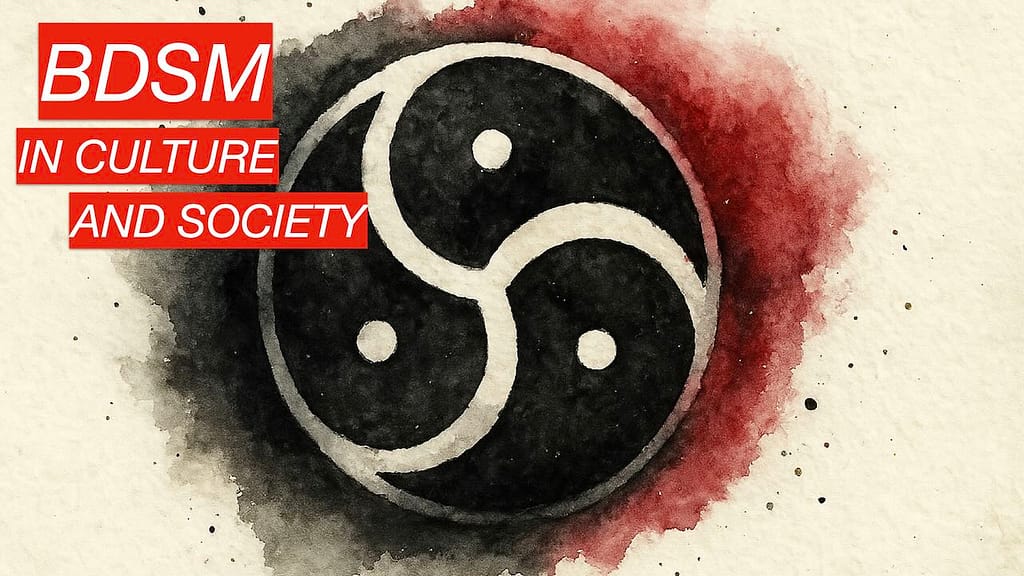
From niche to mainstream: BDSM in culture and society
BDSM isn’t just a niche. In literature, film/TV, fashion, music, visual arts, and online spaces, themes of power, control, devotion, and consent appear more and more—raising questions about authenticity and responsibility.
Literature: Trailblazers and Popular Hits
From Pauline Réage’s “Story of O” (1954) to mass-market phenomena like “Fifty Shades of Grey”, literature has long tested boundaries, explored desire, and made intimate dynamics narratable.
While classics often present ambivalence or provocation, contemporary bestsellers open the door to wider audiences—sometimes at the expense of realistic portrayals of safety and consent. What matters most: good writing shows not only marks and sensations, but also communication, renegotiation, and aftercare.
What was taboo 30 years ago now appears on runways, in movie theaters and streaming platforms: BDSM aesthetics and dynamics have moved from the underground into pop culture.
Cinema Between Cliché and Education
Filmmakers face a challenge: how to portray complex interpersonal dynamics authentically without turning them into mere spectacle? Art-house films like Secretary or The Duke of Burgundy carefully depict negotiation, safewords, and aftercare, while mainstream productions often reduce BDSM to red rooms and handcuffs.
Fantasy stories such as Fifty Shades don’t depict reality; they visualize the author’s head-cinema. Still, Fifty Shades helped destigmatize BDSM. It’s now possible to talk about it without blushing—it’s indisputably a mass-market phenomenon and, factually, part of the mainstream.
Fashion as Cultural Translation
The fashion industry has long detached BDSM elements from their original context. Straps, harnesses, and corsets become sculptural design tools in haute couture, while streetwear borrows streamlined references like chokers or utility belts.
Music as an Emotional Map
Industrial, EBM, and goth make power play audible—through hard rhythms, noise textures, and live performances. Pop artists use BDSM imagery as statements about self-determination, and music videos stage mini-scenarios of control and surrender. From Madonna to Depeche Mode, the theme has been explored; audiences are no longer easily shocked.
Art as a Space for Reflection
Photography and performance art are ideal fields to explore gaze, power, and the body. Shibari photography emphasizes both aesthetic beauty and trust. Performance work uses discipline and devotion to ask questions about autonomy and consent.
The History of BDSM: From Hidden Rooms to Public Discourse
Talking about BDSM no longer requires a whisper. Between education, community etiquette, and fashion aesthetics, a field has emerged that feels both old and new. Old, because the desire for power and surrender is as old as humanity. New, because language, ethics, and public discussion have matured only in recent decades. This history isn’t a straight line, but a zigzag of secrecy, scandal, research, prohibition, and emancipation.
Forerunners: Ecstasy, Asceticism, Secret Salons
Long before the term BDSM existed, ritual, pain, and ecstasy were known. Medieval religious flagellation connected asceticism with transcendence. Courtly and libertine circles played with humiliation and power in letters and boudoirs. What was missing was a vocabulary for consensuality and role-play as a principle of pleasure. The desire was there—the words were not.
18th–19th Centuries: Writing the Forbidden
In the 18th and 19th centuries, the secret play became textual. Marquis de Sade provoked with radical fantasy; Leopold von Sacher-Masoch sketched a blueprint for aestheticized submission in Venus in Furs. Early sexology began to catalog the unusual: Richard von Krafft-Ebing pathologized “deviations” in Psychopathia Sexualis. Between fascination and diagnosis, a tension emerged that would accompany BDSM for a long time: art and catalog, desire and stigma.
Weimar, Postwar, Leather: Subcultures Take Shape
In the Weimar Republic, queer and fetish-adjacent milieus flourished—Berlin became a laboratory for gendered and sexual expression. The Nazi regime brutally destroyed this diversity.
After the war, new codes emerged: leather and motorcycle culture in gay communities across North America and Europe became visible, proud symbols of masculinity, toughness, and camaraderie—and thus also of power play. Photography and illustration (notably Tom of Finland’s iconic men) shaped an aesthetic that still resonates.
Japan and the Rope: Kinbaku as a Tradition
In Japan, a distinct rope practice developed. From historical restraint and display techniques arose 20th-century kinbaku/shibari: an aesthetic of lines, breath, and connection. Often less about “immobilizing” than about shared experience of closeness, rhythm, and composition. Since the 1990s this school has influenced Western rope communities that combine safety standards with artistic ambition.
1960s–1980s: Sexual Revolution, Organization, Ethics
With sexual liberalization came the first open BDSM groups. Meetups, clubs, and magazines created space for exchange, learning, and protection. The community’s core concepts emerged: Safe, Sane, Consensual as a minimum standard for responsible play; later Risk-Aware Consensual Kink as a more realistic variant emphasizing informed risk awareness.
Feminist debates wrestled with the question of whether power play is self-empowerment or a reproduction of violence.
1990s: Law, Pathology, Community—A Stress Test
The AIDS crisis professionalized safer-sex and hygiene standards in BDSM contexts. At the same time, consensual practices came under legal scrutiny. High-profile cases in Europe made clear that private consent isn’t protected everywhere. Community responses: more documentation, more negotiation, more public education. Workshops on negotiation, safewords, and aftercare became standard.
The Internet Age: Forums & Findability
The web removed the biggest barrier: isolation. Forums, blogs, and later social media made knowledge and connection accessible. Beginners found checklists, glossaries, and event calendars; advanced players networked internationally. The digital stage made kink more visible—and more discussable.
2010s: Mainstream Meets Niche
With global bestsellers and blockbusters, BDSM became a conversation topic beyond the scene. Effects cut both ways: detabuization increased curiosity and demand, but simplified images spread—often with too little emphasis on consent negotiation and safety. Communities countered with resources: solid guides, YouTube channels, podcasts, and workshops that unite pleasure with responsibility.
2020s: Inclusive, Trauma-Informed, Networked
Today BDSM is more plural than ever. Queer, trans, and neurodiverse perspectives reshape language and practice: gender-neutral titles, flexible roles, session designs that account for triggers and neurotype. Kink awareness reaches therapy, coaching, and medicine. Festivals and play parties work with awareness teams, consent stations, and quiet rooms.
Language Creates Reality: From Pain to Meaning
Perhaps the least visible change is language. Where shame and pathologization once dominated, we now have words that enable action: negotiation, safeword, aftercare, check-in, consent violation, accountability. These terms aren’t cosmetic; they’re cultural techniques. They transform raw impulses into shaped encounters and turn risk into a conscious play with boundaries.
United States: From Underground Scenes to Consent Culture
From postwar leather bars to today’s festivals, rope dojos, and educator networks, the United States has been both a crucible and a catalyst for BDSM culture. Cities like San Francisco, New York, Chicago, and Los Angeles helped shape visible communities where safety frameworks, inclusive language, and peer education could develop. Workshops, munches, and community guidelines brought together practical know-how, ethics, and lived experience—filling gaps that mainstream media often left open.
Over time, U.S. kink culture matured from “underground” to openly discussed consent-based practice. The emphasis today is on negotiation, informed risk awareness (SSC/RACK), aftercare, and accessibility—inclusivity for queer, trans, neurodivergent, and disability communities. This evolution shows that BDSM in the U.S. isn’t a tale of scandal, but of a growing culture: curiosity paired with responsibility, fantasy balanced by care, and play grounded in structure and consent.
Notable Pop-Culture Figures with BDSM Connections
Ian Fleming
Ian Fleming (1908–1964), creator of James Bond, brought not only intelligence-world knowledge to his novels but also a recurring fascination with flagellation and power play.
Biographical sources describe Fleming as someone not averse to discipline themes. Source: The Times (London). The motif echoes in Bond’s world: torture and interrogation scenes mark dramatic turning points, sharpen hierarchies between perpetrator and hero, and drive the plot (iconically in Casino Royale or Goldfinger).
This consistent staging of pain, risk, and control turned Bond into a mainstream vehicle for themes otherwise relegated to the borderlands between eroticism, violence, and psychology—and shows how tightly thriller suspense and BDSM codes can interweave in pop culture.
- Dita Von Teese (burlesque icon; emerged from fetish/bondage modeling and brought fetish aesthetics into the mainstream).
- Madonna (pop icon; since the early ’90s, used fetish/BDSM imagery in videos, her photo book Sex, and tours).
- Lady Gaga (pop-culture phenomenon; employs harness, latex, and bondage cues as artistic codes for power/roles).
- Rihanna (superstar; normalized fetish vocabulary with “S&M” and dominant stage looks).
- Grace Jones (style and performance icon; androgynous power image, latex/harness, dominant staging).
- Janet Jackson (pop legend; the “Velvet Rope” era with “Rope Burn” brought bondage/control themes to arena stages).
- Nine Inch Nails / Trent Reznor (industrial; themes of power, control, and corporeality—iconic: “Closer”).
- Rammstein (industrial metal; theatrical shows with dominance/submission motifs and fetish props).
- Marilyn Manson (shock rock; uses latex, leather, and restraint metaphors for provocation and boundary play).
- Jean Paul Gaultier (designer; corsets, harnesses, and fetish codes anchored in haute couture and pop culture).
- Alexander McQueen (designer; dark, subversive shows with bondage details and power choreography).
- Helmut Newton (photographer; iconic, provocative series with fetish, power, and dress-code themes).
Subscribe to our inner circle newsletter and never miss an article.
Glossary
Directory (click to expand)
SSC: Safe, Sane, Consensual – secure, “sensible,” consensual.
RACK: Risk Aware Consensual Kink – risk-aware and consensual.
Aftercare: Physical-emotional care process after scenes.
D/s: Dominance/submission – power differential as agreed role(s).
Consent: Prior, informed agreement by all participants – revocable at any time.
Safeword / Traffic-light system: Agreed stop words or signals (e.g. Green/Yellow/Red) to adjust intensity or end immediately.
Hard Limits: Absolute taboos that are never crossed.
Soft Limits: Boundaries that are possible only under certain conditions or approached gradually.
Negotiation: Pre-scene exchange about desires, limits, health, tools, safewords, and aftercare.
Subspace: Trance-/flow-like state for subs caused by endorphins, focus, and surrender.
Topspace: Counterpart for the Top/Dominant – concentrated, responsible “leadership” and presence zone.
Switch: A person who can switch between Top and Sub depending on partner/setting.
Dominant (Dom/Domme): Leading role; sets the framework, carries responsibility, and respects agreements.
Sub/Bottom: Receiving role; gives up defined control and communicates feedback/limits.
Bondage: Restraint with ropes, straps, or hardware for fixation, posture, or aesthetics.
Shibari/Kinbaku: Japanese rope art emphasizing line flow, rhythm, and connection.
Suspension: Suspension bondage – requires high technical skill and safety.
Impact Play: Striking play (hand, paddle, flogger, cane, etc.) – observe clearly defined impact zones.
Spanking: Smacks/spanks on buttocks or thighs – ranging from playful to intense.
Flogger: Multi-tailed “whip” for broad, whipping sensations; intensity highly variable.
Cane: Rigid striking instrument for precise, pinpoint intensity.
Paddle: Flat striking tool (leather/wood), creates a dull, broad impact.
Sensation Play: Play with tactile stimuli (feather, ice, wax, claws) – contrasts of soft/rough, cold/warm.
Electroplay (E-Stim): Electrical stimulation via devices/electrodes – only with proper equipment, never across the chest/heart.
Breath Play: Restriction of breathing – medically risky. Many experts strongly advise against. If at all, only by extremely experienced players, with emergency plan.
Edge Play: Play at the edge of orgasm. “Edging” means bringing someone to the brink without climax. Often linked with Tease & Denial.
Humiliation Play: Consensual humiliation/shame play – boundaries, triggers, and aftercare are essential.
Protocol: Agreed behavioral rules/etiquette in D/s daily life (forms of address, posture, rituals).
Collar / Collaring / Day-Collar: Symbolized bond in D/s; day-collar as discreet everyday version.
Sub-/Top-Drop: Later hormonal/mood low after intense scenes – buffered by good aftercare.
Chastity: Control of orgasms/ejaculation via rules or devices; often combined with Tease & Denial.
Tease & Denial: Targeted arousal without permission for release – builds tension and focus.
Medical Play: Roleplay/settings with medical aesthetics/tools – hygiene, safer sex, and expertise are mandatory.
Pet Play: Roleplay as “animal” (pony/pup/cat etc.); focus on behavior, training, service, and nonverbals.
FAQs
What is BDSM?
BDSM includes consensual practices and relationship dynamics around Bondage & Discipline, Dominance & Submission, and Sadism & Masochism – with clear agreements, limits, and safety.
Is BDSM an illness or diagnosis?
No. Consensual BDSM is not a diagnosis. It becomes pathological only in the absence of consent or with severe distress/impairment.
How common is BDSM?
Many people have fantasies about power/powerlessness; a smaller but significant group practices it. Numbers vary depending on study and definition.
What roles exist?
Dom/Domme/Top (leading), Sub/Bottom (receiving), and Switch (switches depending on setting). Roles are negotiated and may be permanent or situational.
What is an “Alpha Sub”?
A confident, competent sub who voluntarily and actively surrenders power, communicates limits clearly, and delivers high-quality service/protocol – without “topping from the bottom.”
What do SSC and RACK mean?
SSC: Safe, sane, consensual. RACK: Risk-aware consensual kink – know, weigh, and consensually accept risks.
How do beginners start?
Slowly, with pre-scene talk (wishes/taboos), safeword, clear signals, and aftercare. Start with lower-risk practices and build knowledge.
What happens in a session?
Agreed roles, rituals, and practices in a safe framework; focus is on communication, feedback, and consent – before, during, and after the session.
What is aftercare – and why important?
Planned care (warmth, drinks, cuddling, talk). Stabilizes body and emotions, prevents drop, deepens trust.
What is a fetish in BDSM?
A strongly focused stimulus (object/material/action/body part) that triggers arousal – e.g. leather, latex, ropes, high heels. Fetishes are part of consensual scenarios.
Is breath control safe?
Medically risky (e.g., hypoxia, arrhythmia). Many advise against. If practiced at all, only by highly experienced players, with rules and emergency plan – never alone.
What BDSM furniture is common?
St. Andrew’s cross, spanking bench, bondage frame/bed, stocks, cages, gynecological chair, suspension frame, bondage chair.
How to find reputable community or professionals?
Through local munches/clubs/workshops, trusted directories, and recommendations. With professionals, look for transparent info, clear rules, and professional communication.
What to do about sub-/top-drop?
Rest, warmth, drinks/food, gentle contact, debrief; possibly sleep and days off. Seek professional help if discomfort persists.
How to set limits and taboos?
Yes/No/Maybe list, written record (e.g., “slave contract” without legal force), traffic-light system, and nonverbal signals. Limits can be revoked anytime.
Who writes on Lady-Sas.com?

Hi, we are Lady Sas and Lady Victoria, two private Femdoms from Frankfurt am Main. We are experts and authors on Femdom, BDSM, FLR, Cuckolding, Chastity, and Sissification.
With our website, we want to encourage private women to discover their dominance and enjoy their lust. We also want to encourage submissive men to feel comfortable in their role.
Note on language & inclusivity: Examples sometimes use “woman/man,” but always mean all genders and identities (e.g., trans, non-binary, intersex). Roles in BDSM are independent of gender, body, or orientation. Consent, respect, and safety apply in all constellations.
→ Femdom Guide • BDSM Guide • Tease and Denial Guide • Dominatrix Interviews • Cuckolding Guide • FLR Guide


